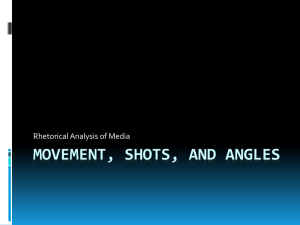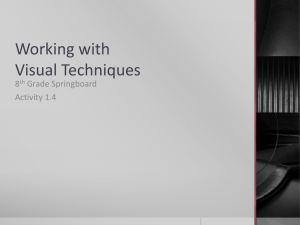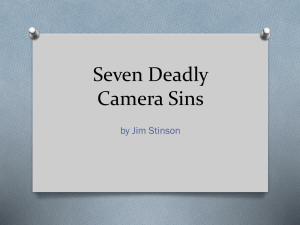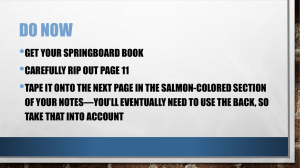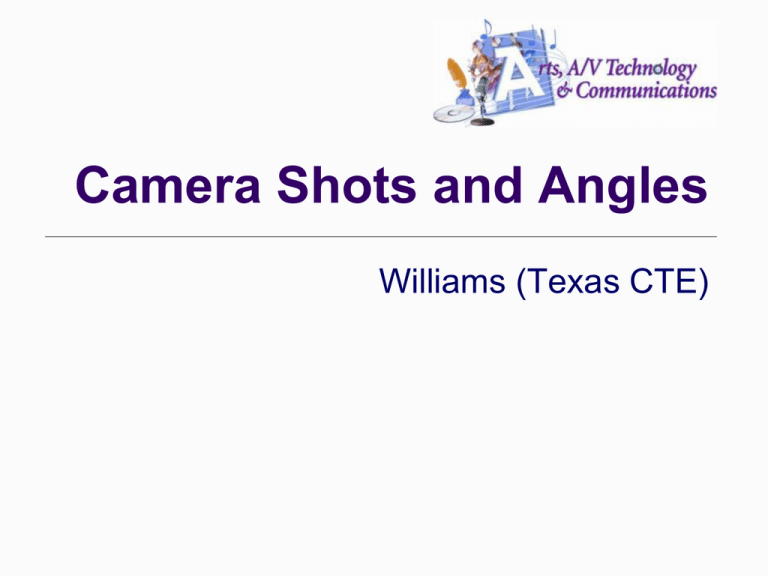
Camera Shots and Angles
Williams (Texas CTE)
Visual Focus
Always ask yourself, “Where do I expect my view to
look?”
Arrange your visual elements and camera so your
viewers easily understand where to look.
In most situations, do not position the subject
centrally in the picture.
Use the rule of thirds by visually dividing the width
and height of the frame into three parts. Try to put
the most important object at one of the intersections
(top left, top right, bottom left, bottom right).
Copyright © Texas Education Agency, 2011. All rights reserved.
Images and other multimedia content used with permission.
2
Camera Shots: Wide and
Establishing Shots
Wide shot – This is the name for a shot
which is taken from a long way away showing
the surroundings and the actor(s).
Establishing Shot – A wide shot that lets the
audience know where the action is taking
place. Usually, your audience has to
understand the setting at or near the
beginning. Sometimes, you might choose to
hide the setting from the audience on
purpose.
Copyright © Texas Education Agency, 2011. All rights reserved.
Images and other multimedia content used with permission.
3
Wide Shot
Image 9. Used with permission.
Copyright © Texas Education Agency, 2011. All rights reserved.
Images and other multimedia content used with permission.
4
Camera Shots: Long
Shot
Long shot – This is closer than a wide shot.
You can see the person from head to toe, but
you can still see what's around them. Many
times the action is best displayed using this
full-body shot.
Copyright © Texas Education Agency, 2011. All rights reserved.
Images and other multimedia content used with permission.
5
Long Shot
Image 10. Used with permission.
Copyright © Texas Education Agency, 2011. All rights reserved.
Images and other multimedia content used with permission.
6
Camera Shots: Medium
Shot
Medium shot – This shows someone from
just below their waist to just above their head.
When you use a medium shot, the viewer is
close enough to see actor's expressions but
can see what the actors are doing with their
hands as well.
Copyright © Texas Education Agency, 2011. All rights reserved.
Images and other multimedia content used with permission.
7
Medium Shot
Image 11. Used with permission.
Copyright © Texas Education Agency, 2011. All rights reserved.
Images and other multimedia content used with permission.
8
Camera Shots: Close-up
Close-up – This shows just the head of the
person being filmed. You can use this sort of
shot when it's important to see someone's
expression: for example, if they are scared or
angry.
Extreme Close-up – A dramatic shot that
shows the actors eyes and mouth.
Copyright © Texas Education Agency, 2011. All rights reserved.
Images and other multimedia content used with permission.
9
Close-Up
Image 12. Used with permission.
Copyright © Texas Education Agency, 2011. All rights reserved.
Images and other multimedia content used with permission.
10
Shot Comparison
Image 13. Used with permission.
Copyright © Texas Education Agency, 2011. All rights reserved.
Images and other multimedia content used with permission.
11
Camera Shots: 1, 2, 3,
OTS
One Shot – Only one actor is in the frame.
Two Shot – Two actors are in the frame.
OTS – Over the Shoulder Shot. A two shot which
puts focus on the character facing the camera. This
shot sets up for the One Shot, as if the viewer has
assumed the other character’s point of view (POV).
Three Shot – Three actors. Angle the camera so
that the focal point actor is closest. Look at the
triangle created by the three actors. The “power
spot” is the top of the triangle.
Copyright © Texas Education Agency, 2011. All rights reserved.
Images and other multimedia content used with permission.
12
OTS – Over the Shoulder
Image 14. Used with permission.
Copyright © Texas Education Agency, 2011. All rights reserved.
Images and other multimedia content used with permission.
13
Camera Shots: Inserts
An insert shot is a full screen close-up of
actions, objects, text, or a character’s reaction
placed as if inserted over a longer scene or
over dialog.
Copyright © Texas Education Agency, 2011. All rights reserved.
Images and other multimedia content used with permission.
14
Insert Example
Image 15. Used with permission.
Copyright © Texas Education Agency, 2011. All rights reserved.
Images and other multimedia content used with permission.
15
Camera Shots: Dutch
Angle
A Dutch Angle tilts the camera on its bank axis
which slants the horizon. It is used to create
tension in a scene. Fast shots at a Dutch Angle
might be used during a chase scene, a fight
scene, or when a character becomes violent or
confused.
Copyright © Texas Education Agency, 2011. All rights reserved.
Images and other multimedia content used with permission.
16
Dutch Angle Example
Image 16. Used with permission.
Copyright © Texas Education Agency, 2011. All rights reserved.
Images and other multimedia content used with permission.
17
Camera Movement: Dolly
Dolly is moving the camera into the shot,
getting closer to the action. This is similar to
zooming in on the action.
To show this on the storyboard, a floating
frame is draw to show the final placement.
Arrows from the corners of the original frame
to the new frame indicate trucking.
Use thick white arrows to show camera
moves and thin black arrows to show objects
or actors moving.
Copyright © Texas Education Agency, 2011. All rights reserved.
Images and other multimedia content used with permission.
18
Dolly Storyboard
Image 17. Used with permission.
Copyright © Texas Education Agency, 2011. All rights reserved.
Images and other multimedia content used with permission.
19
Camera Movement: Pan
Panning is rotating the camera on a tripod to
slowly reveal a wide section.
To show this on the storyboard, create a wide
drawing and use a floating frame. Connect
the frames with arrows to indicate the
direction and mark “start” and “stop” on the
appropriate frames.
Normal storyboard paper often makes this
difficult to show. A wider panel frame is
better.
Copyright © Texas Education Agency, 2011. All rights reserved.
Images and other multimedia content used with permission.
20
Storyboard Pan
Image 18. Used with permission.
Copyright © Texas Education Agency, 2011. All rights reserved.
Images and other multimedia content used with permission.
21
Camera Movement:
Trucking
Trucking is the lateral movement of the
camera. Like panning, it reveals a wide
section.
Trucking usually follows an actor or an object,
so the background is actually moving through
the frame.
Keep some space in front of a character in
the direction they are moving. Don’t crowd
into the edge of the frame.
Copyright © Texas Education Agency, 2011. All rights reserved.
Images and other multimedia content used with permission.
22
Camera Movement:
Trucking
To show this on the storyboard, use a circled
“BG” with arrows to indicate which direction
the background is moving.
It may or may not be necessary to draw the
entire background on a wide panel with a
floating frame.
Copyright © Texas Education Agency, 2011. All rights reserved.
Images and other multimedia content used with permission.
23
Storyboard Trucking
Image 19. Used with permission.
Copyright © Texas Education Agency, 2011. All rights reserved.
Images and other multimedia content used with permission.
24
Transitions
When possible, help your audience with
scene transitions by hinting at the new
location in the final frame prior to the cut.
Example: First scene is in a school hall and
second shot in a classroom. Show the door to
the classroom prior to the transition.
Special transitions may be needed for the
passage of time, flash backs, dreams, etc.
Simply write on the panel a description: clock
wipe or fade to black.
Copyright © Texas Education Agency, 2011. All rights reserved.
Images and other multimedia content used with permission.
25
Image Credits
Image 01. Storyboard. Created by Aaron Gallimore. Used with permission.
Image 02. Storyboard. Created by Aaron Gallimore. Used with permission.
Image 03. Photo of microphone. Photograph by Doctor Bob. Used. with permission from MorgueFile.com
(http://www.morguefile.com/archive/display/55317).
Image 04. Photo of drawings. Photograph and drawings by Mark Harman. Used with permission.
Image 05. Storyboard paper. Created by Gladys Cardenas. Used with permission.
Image 06. Rules of thirds. Created by Summer Pirkle. Used with permission.
Image 07. Horizon examples. Created by Mark Harman. Used with permission.
Image 08. Lens examples. Created by Mark Harman. Used with permission.
Image 09. Boy at locker (wide). Created by Mandy Lansford. Used with permission.
Image 10. Boy at locker (long). Created by Mandy Lansford. Used with permission.
Image 11. Boy at locker (medium). Created by Mandy Lansford. Used with permission.
Image 12. Boy at locker (close-up). Created by Mandy Lansford. Used with permission.
Image 13. Boy at locker (shot comparison). Created by Mandy Lansford. Used with permission.
Image 14. Drawing of man and witch (ots). Created by Summer Pirkle. Used with permission.
Image 15. Drawing of man by subway (insert). Created by Mark Harman. Used with permission.
Image 16. Drawing of girls in hall (Dutch). Created by Nghi Pham. Used with permission.
Image 17. Drawing of man and volcano (dolly). Created by Mandy Lansford. Used with permission.
Image 18. Drawing of palm trees (pan). Created by Joey Ellerd. Used with permission.
Image 19. Drawing of van and road (trucking). Created by Mark Harman. Used with permission.
Copyright © Texas Education Agency, 2011. All rights reserved.
Images and other multimedia content used with permission.
26




